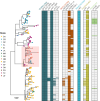Multidrug-resistant Shigella flexneri outbreak affecting humans and non-human primates in New Mexico, USA
- PMID: 40393962
- PMCID: PMC12092818
- DOI: 10.1038/s41467-025-59766-3
Multidrug-resistant Shigella flexneri outbreak affecting humans and non-human primates in New Mexico, USA
Abstract
Shigellosis is a gastrointestinal infection caused by species of Shigella. A large outbreak of Shigella flexneri serotype 2a occurred in Albuquerque, New Mexico between May 2021 and November 2023 that involved humans and non-human primates (NHP) from a local zoo. We analyzed the genomes of 202 New Mexican isolates as well as 15 closely related isolates from other states, and four from NHP. The outbreak was initially detected within men who have sex with men but then predominantly affected people experiencing homelessness. Nearly 70% of cases were hospitalized and there was one human death. The outbreak extended into Albuquerque's BioPark Zoo, causing high morbidity and six deaths in NHPs. All isolates were multidrug-resistant, including towards fluoroquinolones, a first line treatment option which led to treatment failures in human and NHP populations. We show the circulation of the same S. flexneri strain in humans and NHPs, causing fatalities in both populations. This study demonstrates the threat of antimicrobial resistant organisms to vulnerable human and NHP populations and emphasizes the value of genomic surveillance within a One Health framework.
© 2025. The Author(s).
Conflict of interest statement
Competing interests: After the manuscript had entered peer‑review, D.L.D. accepted a position at Illumina; this new employment commenced after all data collection and primary analyses were completed and did not influence the study design, interpretation of results, or the preparation of this manuscript. The remaining authors declare no competing interests.
Figures



Update of
-
Multidrug-resistant Shigella flexneri outbreak associated with a high-mortality spillover event into nonhuman primates.Res Sq [Preprint]. 2024 Jul 12:rs.3.rs-4682172. doi: 10.21203/rs.3.rs-4682172/v1. Res Sq. 2024. Update in: Nat Commun. 2025 May 20;16(1):4680. doi: 10.1038/s41467-025-59766-3. PMID: 39041026 Free PMC article. Updated. Preprint.
References
-
- Kotloff, K. L., Riddle, M. S., Platts-Mills, J. A., Pavlinac, P. & Zaidi, A. K. M. Shigellosis. Lancet391, 801–812 (2018). - PubMed
-
- Puzari, M., Sharma, M. & Chetia, P. Emergence of antibiotic resistant Shigella species: A matter of concern. J. Infect. Public Health11, 451–454 (2018). - PubMed
-
- CDC Health Alert Network. Increase in Extensively Drug-Resistant Shigellosis in the United States. https://emergency.cdc.gov/han/2023/han00486.asp (2023).
-
- Charles, H. et al. Outbreak of sexually transmitted, extensively drug-resistant Shigella sonnei in the UK, 2021–22: a descriptive epidemiological study. Lancet Infect. Dis.22, 1503–1510 (2022). - PubMed
MeSH terms
Substances
Grants and funding
- KL2 TR001448/TR/NCATS NIH HHS/United States
- UL1 TR001449/TR/NCATS NIH HHS/United States
- KL2TR001448/U.S. Department of Health & Human Services | NIH | National Center for Advancing Translational Sciences (NCATS)
- UL1TR001449/U.S. Department of Health & Human Services | NIH | National Center for Advancing Translational Sciences (NCATS)
LinkOut - more resources
Full Text Sources

